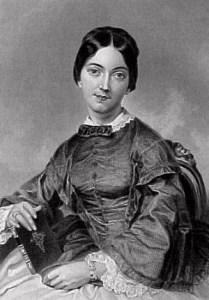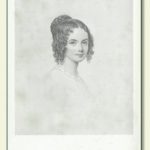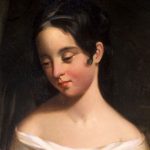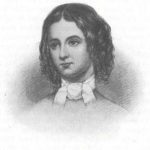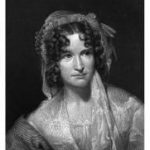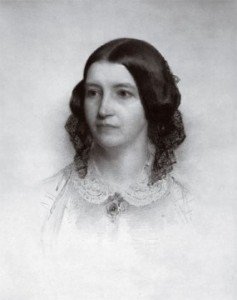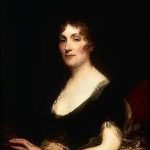Frances Sargent Osgood was one of the most popular women writers and poets of the mid-nineteenth century. Though some critics berated her writing as overly sentimental, Osgood achieved a wide readership and her fame was based on her success as an author, not merely for her connection to Edgar Allan Poe.
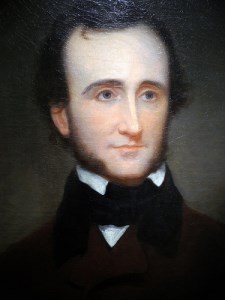
Image: Frances Sargent Osgood and Edgar Allan Poe (painting of Poe by Fanny’s husband)
Early Life
Frances Sargent Locke was born on June 18, 1811 in Boston, Massachusetts to Joseph Locke, a wealthy merchant, and his second wife Mary. Fanny, as she was known, spent her early years in Hingham, Massachusetts, and probably received her formal education at home by private tutors, but she also attended the Boston Lyceum for Young Ladies in 1828. Her poetry was first published when she was fourteen in a children’s magazine called Juvenile Miscellany by editor Lydia Maria Child.
Marriage and Family
In 1834, Fanny met young portrait artist Samuel Stillman Osgood at the Boston Athenaeum. He asked her to sit for a portrait. They were engaged before the portrait was finished and married on October 7, 1835. Shortly after the wedding, the Osgoods moved to London, where Samuel continued to study art. On July 15, 1836, Fanny gave birth to their first daughter, Ellen Frances.
Literary Career
During the next three years, the Osgoods were members of London’s high society. Samuel painted the portraits of England’s elite families, while Fanny published two poetry collections: A Wreath of Wild Flowers from New England (1838) which included “Elfrida,” a dramatic poem in five acts, and The Casket of Fate (1839). She sometimes wrote under the pseudonyms Kate Carol and Violet Vane.
When they returned to the United States in 1839, the Osgoods settled in Boston, and Fanny gave birth to their second daughter, May. In 1842 they moved to New York, where Fanny quickly became a prominent member of the city’s literary salons. During the ensuing years, she published several volumes of poetry, including The Poetry of Flowers and Flowers of Poetry (1841), The Snowdrop, a New Year Gift for Children (1842), Rose, Sketches in Verse (1842) and Puss in Boots (1842).
During this time, Osgood also contributed poems, essays and short stories to the widely popular literary magazines, such as the Broadway Journal, Graham’s Magazine and The Columbian Magazine. Some of her other published works were The Marquis of Carabas (1844) and The Cries of New-York (1846). She was very open and personal in her writings, often discussing the relationships she had with others.
A large portion of her body of work is sentimental or love poetry but she also addresses poems to her mother, her sister, her husband and friends. Literary historian Emily Stipes Watts stated that the poems written to her children are not sentimental, but “honest attempts to express thoughts and emotions never so fully expressed before by women in poetry.”
Osgood was a prolific author and one of the most admired women poets of the 1840s, but her personal life was not nearly as successful. Samuel Osgood left his wife and children to follow the Gold Rush in California. During his absence, Fanny carried on a very public flirtation with poet Edgar Allan Poe, whose wife Virginia Clemm was still very much alive.
Relationship with Edgar Allan Poe
In February 1845, Poe gave a lecture in New York in which he criticized American poetry, especially that of Henry Wadsworth Longfellow. He also mentioned Fanny Osgood, saying that she had “a rosy future” in literature. In a letter to a friend she wrote that Poe was “called the severest critic of the day,” making his compliment that much more impressive.
Anne Charlotte Lynch was a poet who hosted weekly literary soirees at her New York City home during the time Edgar Allan Poe resided there (1844-1846). Throughout 1845, Poe was a favorite guest at those parties. Over the course of his visits to Lynch’s home, he befriended many of New York’s leading writers. It is believed Osgood and Poe first met there in March 1845 while Osgood and her husband were separated.
In a letter to one of Poe’s other admirers, Sarah Helen Whitman, Osgood wrote:
I meet Mr. Poe very often at the receptions. He is the observed of all observers. His stories are thought wonderful, and to hear him repeat the Raven, which he does very quietly, is an event in one’s life. People seem to think there is something uncanny about him, and the strangest stories are told, and, what is more, believed, about his mesmeric experiences, at the mention of which he always smiles. His smile is captivating!…. Everybody wants to know him; but only a very few people seem to get well acquainted with him.
Poe’s wife Virginia Clemm Poe was in very poor health at the time, suffering from consumption (now called tuberculosis), and he may have been attracted to Fanny because of her childlike qualities, which were similar to those of his wife. Osgood socialized with Poe at literary salons, and visited him and his wife at their home. Mrs. Poe approved of the relationship, and believed their friendship had a “restraining” effect on her husband, who had given up alcohol to impress Osgood.
Osgood and Poe engaged in a heavy literary courtship, exchanging poems to each other in Poe’s own magazine, the Broadway Journal. On December 13, 1845, the Broadway Journal printed a review of Poems, a collection of poetry by Fanny Osgood, in which Poe praised Osgood’s work for its “happy refinement” and noted that its author “gives a charm inexpressible to everything which flows from her pen.” Poe’s opinion of Osgood’s work may have been partially tainted by their personal relationship.
Another of the attendees at Lynch’s soirees who took a romantic interest in Poe was poet Elizabeth Ellet, another married woman. Although Poe did not return her affections, Ellet continued to send him love letters. She may be the woman Elizabeth Oakes Smith referred to in this account:
A certain lady… fell in love with Poe and wrote a love-letter to him. Every letter he received he showed to his little wife. This lady went to his house one day; she heard Fanny Osgood and Mrs. Poe having a hearty laugh, they were fairly shouting, as they read over a letter. The lady listened, and found it was hers, when she walked into the room and snatched it from their hands.
In late January 1846, Ellet reported having seen an ‘indiscreet’ letter from Osgood to Poe lying on a table while visiting his house. In an attempt to silence the rumors that had already damaged her reputation in New York literary circles, Fanny sent her friends Margaret Fuller and Anne Lynch to ask Poe to return all the letters Osgood had written to him. Poe responded by saying that Mrs. Ellet should worry more about her own letters to him.
After the women’s departure, Poe gathered up Ellet’s love letters to him and dumped them on her doorstep. Soon after, Ellet and her brother arrived at Poe’s house to demand Ellet’s letters, which he no longer had. Ellet’s brother threatened Poe and he went to another friend, Thomas Dunn English, for a pistol with which to defend himself. English refused and accused Poe of lying about ever having received any letters from Ellet in the first place, and a fist fight broke out.
Although Poe later sent Ellet a letter of apology, Anne Charlotte Lynch removed him from the guest list of her literary salons in early 1846, and Ellet began spreading rumors that he was insane. This was shortly before Lynch’s annual Valentine’s Day party. Though he was not allowed to attend, Poe sent Lynch a Valentine’s poem addressed to Fanny Osgood to be read at the party.
Elizabeth Ellet began spreading new rumors about the Poe/Osgood relationship, going so far as to ask his wife Virginia about the affair. Ellet even suggested that Poe was the father of Osgood’s third child, Fanny Fay, who was born in June 1846. In July 1846 Samuel Osgood threatened to sue Ellet for defamation if she did not apologize to his wife. Ellet responded in a letter, retracting her statements.
Fanny Osgood was already the most widely written about woman in American literature during the 1840s, but her alleged affair with Poe spawned hundreds of stories and poems about the Poe/Fanny/Virginia triangle by others in Fanny’s circle: Elizabeth Oakes Smith, Mary Hewitt, Emma Embury, Lydia Sigourney, Lydia Maria Child, Ann Stephens, Mary Gove Nichols, T.D. English, Philip Pendleton Cooke and Rufus Griswold.
Fanny and Samuel (returned from California) Osgood had reconciled at some point in 1846; they moved to Philadelphia to get away from the scandal, but soon returned to New York. Samuel did not object to Fanny’s relationship with Poe; he had a reputation as a philanderer himself. Fanny went into hiding, and from that point on became reclusive and morose. Her agonies only increased after her infant Fanny Fay died in October. Publicly, her reputation suffered; but privately, her friends rallied around to protect her.
Meanwhile, Poe’s life was also in shambles, both personally and professionally. Due to a lack of funds, he published the last issue of his magazine the Broadway Journal on January 3, 1846. In the early summer of 1846, Poe moved Virginia out of the city to a cottage in the countryside of the Bronx, far from “the tattling of many tongues” where he hoped the country air would improve her failing health. Unfortunately, that was not enough to heal her “weakened lungs.” Virginia Clemm Poe died on January 30, 1847.
Late Years
By this time Fanny Osgood was also suffering from consumption. She was confined to her room because of her illness by 1847. Her daughters were eleven and eight years old at that time and much of her poetry from this period reflects her concern for them and their future. Her husband, having difficulty making money as a painter, left her again for the California Gold Rush in 1849.
Edgar Allan Poe died on October 7, 1849 in Baltimore, Maryland, under mysterious circumstances. This threw Fanny into deeper despair, and she came to be regarded as downright saintly by her peers – for having been victimized by society over her relationship with Poe. She maintained her affection for Poe until the end, including her tribute to him, “The Hand That Swept the Sounding Lyre,” as the final piece in her 1850 collection of poems.
On May 12, 1850, Frances Sargent Osgood died after a long struggle with consumption. She was 38 years old. By then, she had lost her ability to speak; her last word, angel, was written on a slate to her husband, who had recently returned from California. She was buried in her parents’ lot at Mount Auburn Cemetery in Cambridge, Massachusetts.
Osgood’s two surviving daughters also died of consumption the year after their mother; May Vincent Osgood died on June 26 and Ellen Frances died August 31, 1851.
In 1851, a collection of her writings was published by her friends and titled The Memorial, Written by Friends of the Late Mrs. Frances Sargent Locke Osgood. It was reissued as Laurel Leaves in 1854 and was edited with a biographical introduction by Griswold. The volume was meant to raise money for her memorial headstone.
However, author Fanny Fern wrote that the plot remained unmarked in 1854, and criticized Samuel Osgood in her book Fern Leaves from Fanny’s Port-Folio. Samuel Osgood noted in the New York Evening Post that he had already designed a monument, inspired by her poem “The Hand That Swept the Sounding Lyre,” which was soon installed on Fanny Osgood’s grave.
SOURCES
Frances Sargent Osgood
The Fiction of Poe’s Life
Edgar Allan Poe on Valentine’s Day
Wikipedia: Frances Sargent Osgood
